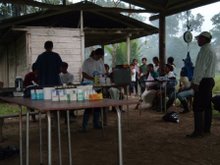As developing countries catch up to the Western world in everything from technology to McDonald's to depression, I think one of the most interesting public health issues to discuss is that of the mounting aging population. According to the article posted under week 1, "Global Aging: The Challenge of Success", by 2050, approximately 80% of the expected population aged 65+ (1.2 of 1.5 billion) will reside in today's less developed regions. As global public health professionals, we must keep this in mind when allocating funds and implementing policies. As social entrepreneurs, we might also recognize an opportunity to create innovative solutions to the anticipated costs of the disease burden of the elderly in developing countries.
In the US, UK, and other European nations, the elderly population is indeed expected to grow, but the bulk of the growth is set to happen in countries like India and China. Other countries with large populations of old people (aged 65+) include the US, Japan, Germany and Russia. Ironically, Russia and Japan are also on the list of countries projected to experience the worst decline in total population—12 and 11 million, respectively. So it is the age structure of the population that is changing. This means that the number of productive people (defined as aged 20-64) in these countries is predicted to drop at an alarming rate, seriously affecting the GDP and creating new health challenges.
In places like India, China, Thailand, Colombia and sub-Saharan Africa, a different phenomenon is developing. With increased buying power, better education and more sophisticated technologies than ever before, these nations are experiencing a similar increase in longevity and a surge in the aging population. According to the article, for instance, Malaysia and Colombia are expected to triple their older populations between 2000 and 2030; sub-Saharan Africa should see an increase of nearly 50% between 2000 and 2015. However, these countries are not experiencing as sharp a decline in their working-age population; while many are seeing ever-decreasing fertility rates, the decrease is not yet reflected in the age structure of these populations to the extent that is seen in more developed countries.
The implications? Developing countries will have more human resources—defined here as sheer numbers of working-age people—than developed countries. Yet simultaneously, the disease burden of the elderly, who in any country consume a disproportionate amount of health resources, will be more of an issue in these less developed nations than in places like the US and Europe. As their economies flourish, and their middle classes expand, will they focus on health care for the elderly? Or will they prioritize instead the health of children and workers, who are the promise, the bread and butter of the nation?
If developing nations do not implement health care policies that care for the elderly, entire countries will suffer from the oversight. India is an example of a country that recognizes this, and responded in 1995 with the centrally funded National Old Age Pension Scheme. While this scheme is 100% government-subsidized, it must be noted that each country is different in terms of its culture, beliefs, resources, history, diversity, form of government and much more. What works in India will not work in nearby Malaysia. What works in an Arab country might be totally inefficient in South America. However, as the article stated, we as future professionals should be thinking in terms of 4 pillars of financial support for health care: public pension, occupational pension, personal savings, and “gradual retirement” of the elderly. Playing with these four forms of funding to find the right formula is and will be an exciting challenge in raising developing economies out of poverty so they can pursue health at each stage of life.
For more information, read "Global Aging: The Challenge of Success."
Wednesday, January 17, 2007
Subscribe to:
Post Comments (Atom)





1 comment:
Farah, all your blogs are so insightful and thought provoking. Nice work so far. It's also nice to see those photos.
Post a Comment